- Home
- Encyclopedia
- Jackson Pollock’s Wyoming Links
Jackson Pollock’s Wyoming Links
A 2022 proposal to name a redrock promontory near Cody, Wyo., “Mount Jackson Pollock” failed. The Wyoming Board of Geographic Names unanimously rejected the proposal after receiving overwhelming negative public comment. The unnamed peak is located on private land. The landowner opposed the name. That opposition carried a lot of weight, especially since the proposal came from a Michigan artist without deep connections to Wyoming or Pollock.
But the proposal did raise an interesting historical question. Did the famous artist have any affinity for Wyoming? Although born in Cody, he moved away with his parents months later and never returned.
The state has never really claimed Pollock. It’s never done much with his legacy. But, research shows, Pollock vigorously claimed Wyoming.
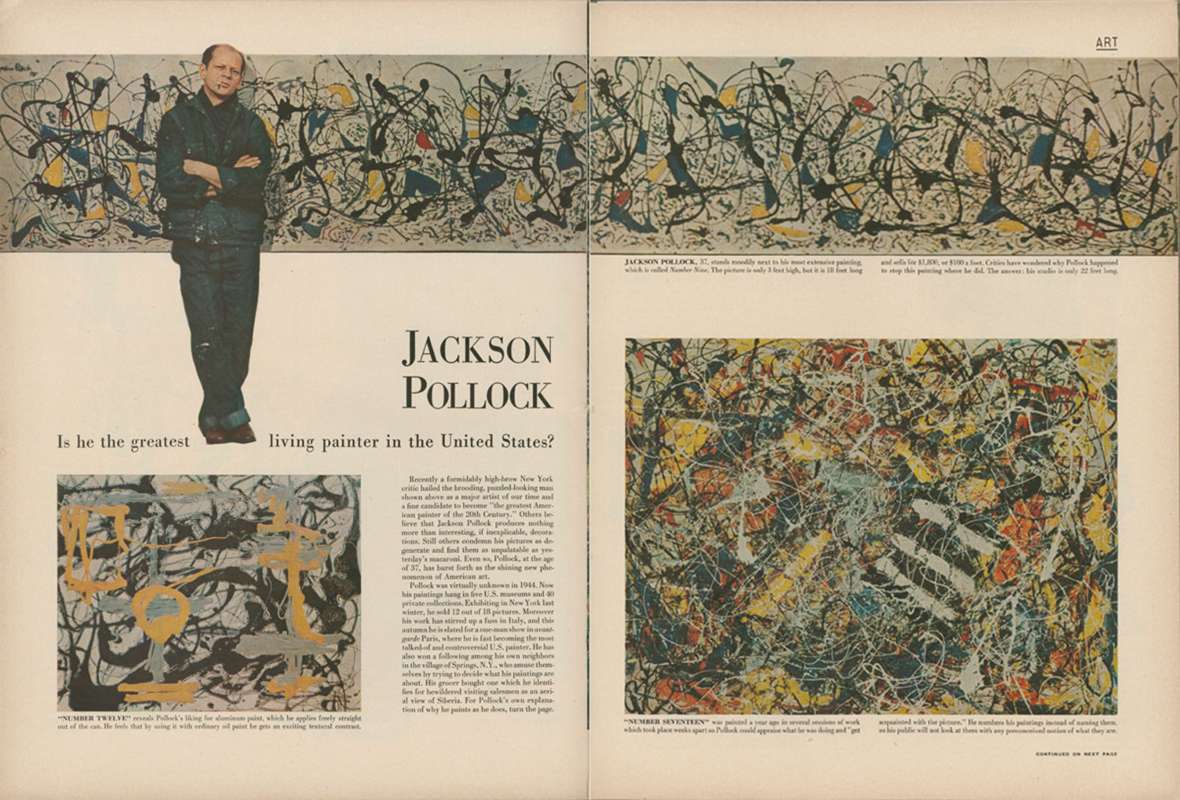
In 1949, Life Magazine roiled the art world with its story, “Jackson Pollock: Is He the Greatest Living Painter in the United States?” In front of one of his controversial “drip” canvases, the 37-year-old artist posed with his arms folded across his paint-spattered black denim smock. He wore a James Dean–like self-confident gaze, a cigarette dangling from his lips. Abstract Expressionism had arrived, with Pollock anointed its leader.
In the article, Pollock proclaimed that he was born in Cody. But in a follow-up story, the Cody Enterprise newspaper could not find a single person in town who remembered him. It noted that he used “a definite style of painting which has never before been used and probably never again will be.”
The next week, the Enterprise acknowledged that Pollock’s claimed birthplace might be authentic. But it nevertheless recalled how a few years previously, Hollywood publicists had fabricated a Cody birth for the cowboy-movie star Roy Rogers. “Cody does not disclaim such noted sons, but is only careful to check on their authenticity,” the newspaper concluded.
Pollock was indeed born east of Cody in 1912—at home, which may be why the courthouse didn’t record a birth certificate. And then his family left Cody before his first birthday, which helps explain why so few people recalled them. Pollock did not return to Wyoming for the rest of his life.
Why then did Pollock highlight his Cody birth in almost every interview? Why did he keep choosing to highlight his associations with Wyoming? Because that detail could explain his looks and actions—could explain the person, and thus the difficult-to-explain art.
Anyone could see that Pollock was handsome, hard-drinking, verbally inarticulate and often reclusive. Associations with Wyoming allowed those traits to pronounce him a cowboy, an individualistic working-class rebel. He was tough. He was cool. He was an American bull in an effete art-world china shop. Such Western connotations created a Roy Rogers–style mythology around Pollock. As much as Pollock’s visionary genius, this narrative drove his fame—for better and for worse.
LeRoy and Stella Pollock arrived in Cody from Iowa in 1903. Lured to “Buffalo Bill’s town in the Rockies” by the idea of a free homestead, the Pollocks found themselves unable to file a homestead claim because the available dryland parcels offered no wood to build a house, and they couldn’t afford to buy wood. LeRoy found work as a dishwasher at the Irma Hotel, and later as a laborer for a rock-crushing outfit. Finally, he took a job at Sanford Watkins’ sheep ranch on lower Sage Creek—in an era when men who worked with sheep were scorned as far inferior to cowboys.
There, in a two-room frame house in January 1912, Stella gave birth to her fifth son, Paul Jackson Pollock. The middle name reflected his father’s favorite mountain town; they called him “Jack.”
Times were tough. LeRoy was suffering from rheumatic fever, an inflammatory heart disease associated with poverty and malnutrition. With no treatment available, the doctor suggested that maybe a warmer climate would help. The autumn after Jack was born, LeRoy left for San Diego, to find a house and a job and then send for his family. On Thanksgiving Day, when Stella had sold the last of their possessions and packed the boys onto a train for the trip south, she lied that he’d succeeded.
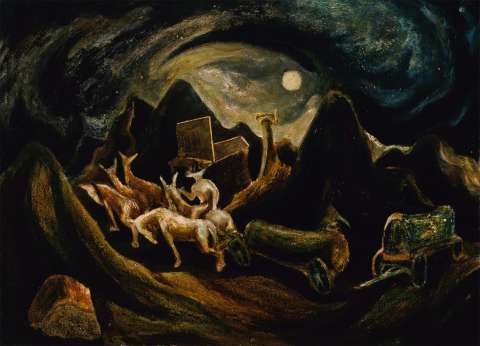
The Pollocks bounced around throughout Jack’s youth: Phoenix, Ariz., plus the California towns and cities of Chico, Janesville, Orland, Riverside and Los Angeles. Jack was a poor student, shy, lonely and isolated. In 1930 he followed his brothers to New York, enrolling in the Art Students League to study under the Regionalist Thomas Hart Benton. Pollock remained undistinguished, with limited capacity for or interest in conventional techniques. Men found him shy and aloof, perhaps talentless. But deep down, he had reserves of passion and creativity, as women, especially, tended to recognize.
Early work
In his early work, Pollock imitated the folksy realism of his mentor Benton. Benton did murals, and Pollock too was enamored of oversized form. But Pollock lacked Benton’s narrative gifts, his ability to use the mural to tell a story.
Pollock spent his 20s in the Great Depression—the nation’s and his own. He briefly worked as a janitor, spent years jobless and on welfare, and eventually received paychecks from the Federal Art Project, a New Deal program to employ muralists and other artists. He also drank a lot.
In the kind view—as exhibited by Deborah Solomon’s magnificent biography Jackson Pollock—Pollock’s drinking resulted from inner turmoil. He loved Benton and the proletarian, anti-Modern realistic style. But his desperate creativity required him to rebel.
Most of his fellow New York artists were creating political art, tinged with communism. Pollock rebelled by never even bothering to vote. Then in 1939, Pablo Picasso’s Guernica was displayed in New York, to great acclaim. Pollock rebelled—and found his genius.
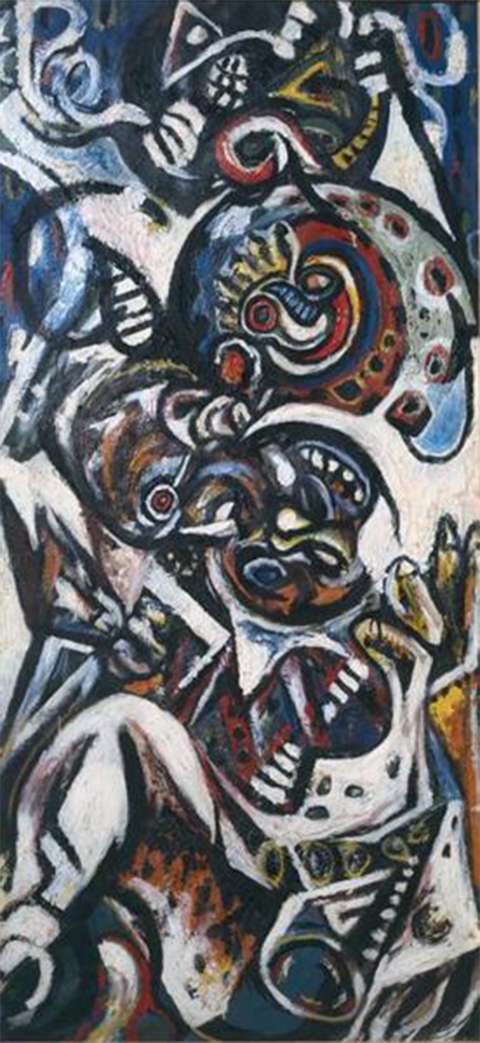
Guernica was a mural, packed with outrage, of images from the Fascist bombing of a Spanish town. It was chaotic, oppressive, nightmarish. It fit the tradition of both Benton’s Regionalism and the New Yorkers’ antifascist politics. But it was abstract. It was art as an expression of overwhelming emotion, rather than narrative. And expressing emotion on canvas was Pollock’s gift.
Soon Pollock met Lee Krasner, a brilliant artist who believed wholeheartedly in him. He started painting large, semi-abstract paintings that gained notice among experts. In Pollock’s first one-man show, November 1943, critics loved his raw energy, crude strength and self-confidence. Works such as The She-Wolf emulated Picasso in their jumble of forms—but they didn’t feel like mere imitations. Pollock was establishing an American response to these groundbreaking European ideas.
That show also included a small work called Composition with Pouring II, Pollock’s first experiment with drips and swirls. But his real breakthrough came a few months later, as he struggled with a mural-sized canvas. He finally decided to arrange swooping black lines across vaguely abstracted forms in white, blue, and yellow. What particularly moved viewers was Mural’s soaring lyricism, the way its intensity cascaded through all twenty-one feet of its length. For the next several years, Pollock explored this style with breathtaking success.
Pollock’s greatest innovation may have been to focus on line. In his great works, you can’t look at a figure, or a form, or even a deeper meaning—so you’re free to focus on the artistic wonder of a line itself. Pollock may not have ever had much talent for drawing figures, but his lines—swooping, curving, widening and narrowing, in paint thick and then thin, across varied backgrounds expressing ever-changing energetic tension—his lines were epic genius.
Nature
It’s possible to trace Western themes throughout Pollock’s career. For example, his early, Benton-like Going West(1934–35) portrayed everyday folks in heroic settings using broad, gestural brushstrokes. As a Westerner, Pollock wanted to apply Benton’s philosophies to his own region. But Going West’s horses and covered wagons were a cultural cliché. They didn’t tell Pollock’s story or even Cody’s—his family had come to and gone from Wyoming by train.
Pollock’s best-known connection to Wyoming may have come through his mentorship of Harry Jackson (1924–2011), a Chicago-born kid who cowboyed near Meeteetse as a teenager. After serving in World War II, Jackson moved to New York because he believed that innovations like Pollock’s were the best artistic techniques to address the trauma of war. Pollock offered his living room as the setting for Jackson’s wedding. Then, after a first show that was compared to Pollock’s in its success, Jackson moved to Cody.
Pollock’s responses to Picasso often invoked Native American themes, and Pollock once compared his drip technique to indigenous sand painting. For example, in Birth (undated but perhaps 1940), he applied Picasso’s style of flattened forms and thick outlines to depictions of an Inuit mask. Likewise, The She-Wolf used Navajo motifs to marry a Picassoesque bull to an American bison.
And critics often saw the freeform brilliance of his high period as reflecting nature. In Autumn Rhythm (1950), for example, he first created a complex linear skeleton using diluted black paint, then laid down white, brown, and turquoise lines. The result was three-dimensional, with paint often layered, sometimes pooled or clotted. Autumn Rhythm could be described as an ecosystem of inter-connected elements expanding horizontally across an endless plain: nature.
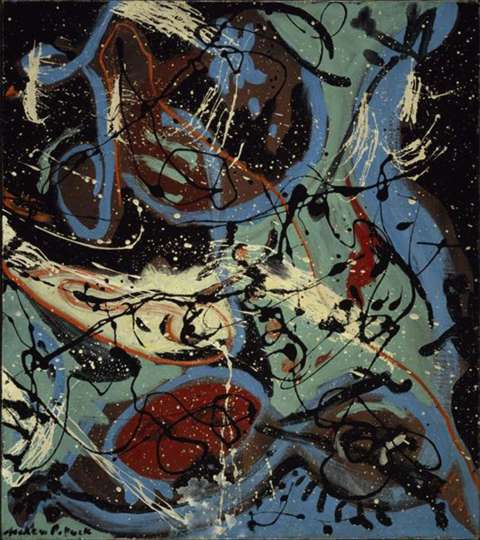
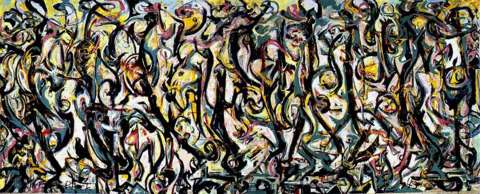
At 17 feet wide and 8 feet high, Autumn Rhythm was also celebrated for its monumentality, the same sense of overwhelming enormity that many people love in the Western national parks. One might argue that Pollock was helping New Yorkers to capture a bit of untamed Wyoming wilderness in their high-end galleries.
Another way to interpret Pollock’s work is to say that it expresses freedom. He captures vibrant energy freed from shape or texture. Indeed, scientists have since demonstrated that Pollock’s paintings are fractal—the apparent chaos of their lines actually follows simple mathematical rules freely adopted in nature.
But the problem with trying to see Western or natural themes in Pollock’s art is the same as trying to see any themes in that art. It’s abstract. He was aiming at what he felt inside, rather than an explicit external theme.
For example, when asked if he worked from nature, Pollock angrily responded, “I am nature.” His questioner, Hans Hofmann, saw through the false bravado in ways that subsequent interpreters often miss. “You work by heart,” Hofmann said. “That’s no good. You will repeat yourself.”
Shrinking frontiers
Pollock’s artistic zenith coincided with success in his personal life. He stopped drinking. He and Krasner got married. They moved to a rural area of Long Island, where neighbors generally knew him as a nice enough guy who did weird paintings in his barn.
Within a few years, however, Pollock reached the far frontiers of his style. He’d dripped and expressed everything he had to “say.” Because of his fame, the world now wanted him to celebrate his brutish technique and fling paint on cue. But “technique is the result of saying something, not vice-versa,” Pollock said. To perform at being an artist trivialized the message of his art. Yet because he couldn’t articulate that message verbally, he proved unsuccessful at living with fame.
Moreover, his success meant that Abstract Expressionism was now an accepted standard—one his personality needed to rebel against. The inner anguish of breaking with himself as an authority figure proved far more challenging than that of breaking with Benton or Picasso.
Pollock started drinking again, heavily. He largely stopped painting, and became paralyzed with self-doubt. His drunken belligerence exasperated friends and colleagues. Krasner suggested they see a couples’ therapist in New York, but Pollock would leave the sessions to go on binges. He began an affair.
Still in love but frustrated by day-to-day existence, Krasner decided to spend the summer of 1956 in Europe. Pollock invited his girlfriend to move in. She quickly became bored by his binges and invited a friend to come visit for a weekend. Driving them around town on August 11, Pollock crashed his car into a tree. The girlfriend survived, but Pollock, age 44, and her friend were both killed on the spot.
Risk and heart
New Yorkers had never understood Pollock’s Wyoming-sized appetite for risk. He took on conventional definitions of painting and art the way a rodeo cowboy takes on a Brahma bull. He was a kayaker faced with a Class V rapid, a free climber at a cliff, Evel Knievel at the Snake River Canyon. For some people, the risk of such challenges makes life worth living.
After Pollock won that confrontation, his work stopped offering productive risk. So he turned to drinking too much and driving too fast. The risk that gave his life meaning turned that life too short.
But at its best, the risk centered on the impossible challenge of his goal. Poor and undereducated, verbally awkward and prone to rage, impatient with traditional pathways to success and thus never having learned the basics of drawing, he nevertheless wanted to thrive in one of the most cutthroat, competitive circles in the world.
Pollock’s great rival for the leadership of that era’s New York art world was Willem de Kooning. De Kooning was known as an artist’s artist. He did figurative as well as abstract art. He drew beautifully. He loved jazz. He could talk to intellectuals. He always mentioned how he was from the Netherlands, home of Rembrandt and Vermeer.
In response, Pollock talked about Wyoming. Wyoming could implicitly point critics to the texture, space and color of Pollock’s canvases, the way they resembled a rich Western landscape. Wyoming could ennoble Pollock’s pouring-dripping-flinging technique with implied comparisons to the physical labor of cowboys. Wyoming could imply being raised poor and common, an underdog in the battle with de Kooning and the intellectual Dutch tradition.
“You know more, but I feel more,” Pollock enjoyed telling his rival. He’d come from the rugged wilderness to conquer New York and de Kooning with nothing but frontier toughness and a bottomless heart.
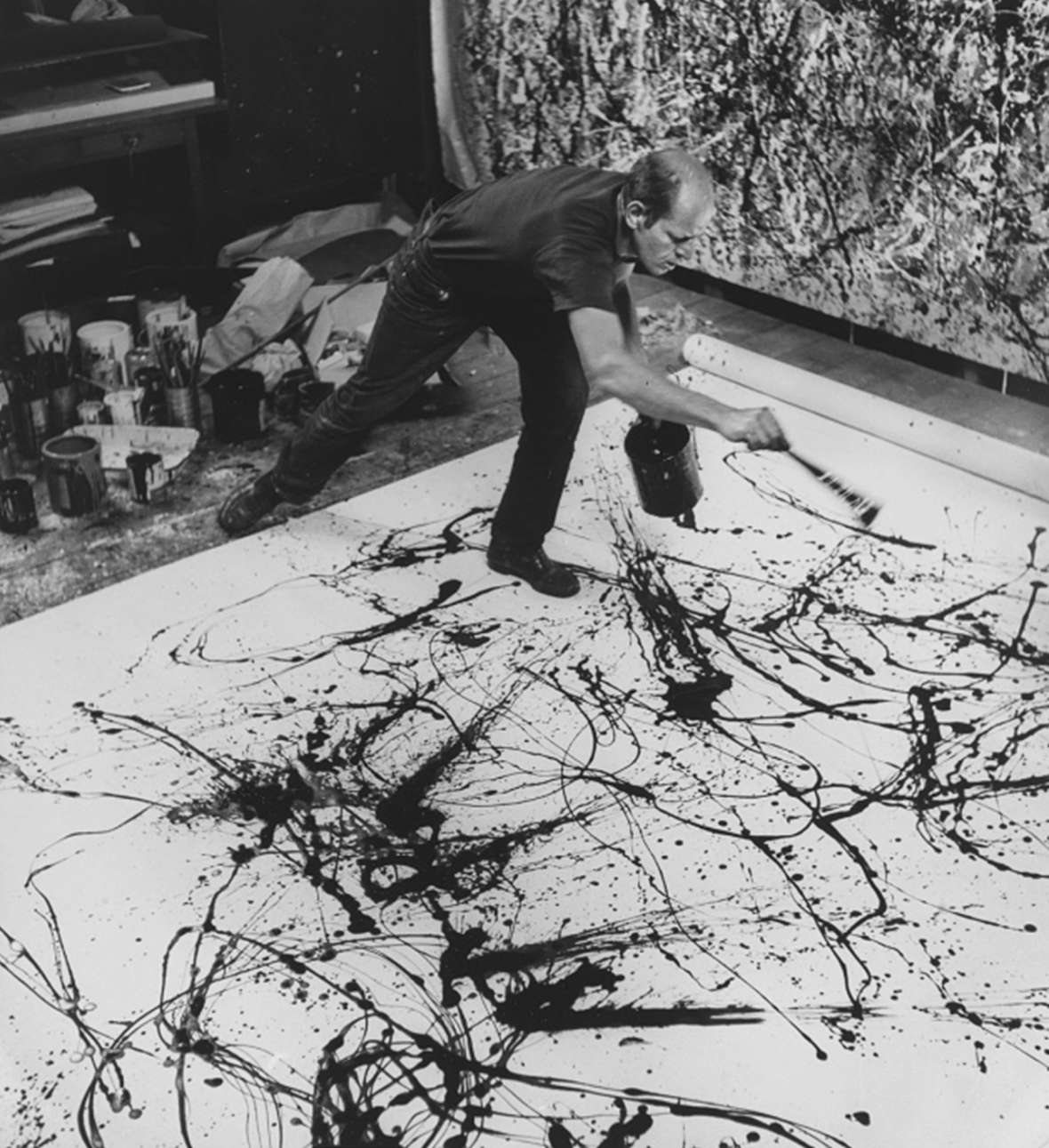
[Editor’s note: An earlier version of this article appeared in Big Sky Journal in 2019.]
Resources
Primary Sources
- Cody Enterprise, August 12 and 19, 1949. Accessed at the Park County Library, Cody Wyoming, in March 2019.
- "Jackson Pollock: Is He the Greatest Living Painter in the United States?" Life, Aug. 8, 1949, 42-45.
Secondary Sources
- Besaw, Mindy N. “Turning Back: Reflecting on the Art of Harry Jackson.” Points West, Summer 2014, accessed August 11, 2022 At https://centerofthewest.org/2019/09/11/points-west-reflecting-art-harry-jackson/.
- Clayton, John. “Jackson Pollock’s Wyoming.” Big Sky Journal, Arts 2019. (From which this article is drawn).
- Friedman, B. H. Jackson Pollock: Energy Made Visible. New York: Hachette Books, 1995.
- Klingsporn, Katie. “Mt. Jackson Pollock? Naming effort for Wyo peak gets mixed reviews.” WyoFile, March 11, 2022, accessed July 18, 2022, at https://wyofile.com/mt-jackson-pollock-naming-effort-for-wyo-peak-gets-mixed-reviews/.
- ______________. “State naming board shoots down ‘Mount Jackson Pollock.’” WyoFile, May 19, 2022, accessed July 18, 2022, at https://wyofile.com/state-naming-board-shoots-down-mount-jackson-pollock/.
- Levin, Gail. “Jackson Pollock, Lee Krasner and a New Concept of ‘Nature.’” Accessed July 18, 2022, at http://www.ritsumei.ac.jp/acd/re/k-rsc/lcs/kiyou/pdf_24-3/RitsIILCS_24.3pp.29-37Levin.pdf.
- _________. Lee Krasner: A Biography. New York: William Morrow, 2011.
- Solomon, Deborah. Jackson Pollock: A Biography. New York: Simon and Schuster, 1987. A major source for this article.
- Taylor, R., A. Micolich, and D. Jonas. “Fractal analysis of Pollock's drip paintings.” Nature 399, 422 (1999), accessed at https://doi.org/10.1038/20833.
Illustrations
- The image of the Aug. 8, 1949 Life Magazine article is from an article at the National Gallery of Art. Used with thanks.
- The photo of Pollock painting in his studio, by Hans Nelmuth, is from the National Portrait Gallery. Used with thanks.
- The image of Composition with Pouring II is from WikiArt. Used with thanks.
- The image of Mural is from the Stanley Museum at the University of Iowa via Wikipedia. Used with thanks.
- The image of Going West is from the Smithsonian American Art Museum. Used with thanks.
- Birth, copyrighted by Pollock-Krasner Foundation, is accessed here via the Tate Modern in London. Used with thanks.
